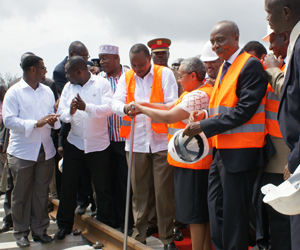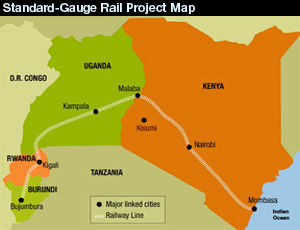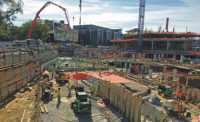

Three Kenyan government groups are investigating allegations of corruption and flawed bidding procedures for a $3.8-billion railway construction contract awarded to China Roads and Bridge Corp. The contract, which covers a 485-kilometer section of the Standard Gauge Railway from the port city of Mombasa to the capital of Nairobi, marks the first phase of a $14-billion railway project that, ultimately, will link Mombasa to Kampala, Uganda.
Alfred Keter, a Kenyan national assemblyman, helped to trigger the probe when he alleged the award of the contract may have been influenced by corruption and noted it had not been procured by an open bidding system. Additionally, Keter asserted the cost of the contract was too high.
Parliament’s public-investments committee, the transport, public-works and housing committee and Kenya’s anti-graft agency launched separate investigations, with final reports expected to be submitted in early March. China Roads and Bridge Corp. (CRBC) is a subsidiary of China Communications Construction Co. (CCCC) Ltd., which was debarred by the World Bank in 2011 for engaging in corrupt business practices related to a Philippines roads project.
The $3.8-billion contract calls for the construction of a 485-km section of the 1,435-millimeter-gauge railway from Mombasa to Nairobi. The wider standard-gauge railway line will replace the narrower, 1,000-mm-gauge Kenya-Uganda Railway line, originally built in 1901. With 33 railyards and terminals, the new system will run parallel to the existing Mombasa-Nairobi highway. According to CRBC, the new railway "will, in some areas, deviate from the existing line in order to attain a relatively straight alignment, which will enhance train speed."
The wider track will enable higher-capacity cargo trains and is expected to reduce shipping costs. Cargo trains will be able to travel at a rate of 80 km/h, while passenger trains can achieve a speed of 120 km/h.
Between Mombasa and Nairobi, the single-track railway will feature 427.3 km of subgrade, 98 bridges, 969 culverts and 77 overpass structures. The majority of the rail system will feature a maximum gradient of 12%, with an allowance of up to 15% in certain sections. Further, the contractor will erect a 1.8-meter-high reinforced-concrete fence along the length of the corridor, CRBC says.
The Chinese firm performed the project’s feasibility study and provided design, cost-estimating services and financing—on the condition the Kenya government awarded CRBC the construction contract.
Kenyan President Uhuru Kenyatta, who commissioned the project last year, has defended the bidding process and blamed “local and international commercial interest groups” for the increasing opposition to the railway.
"The Export and Import Bank of China will provide a commercial loan of $1.6 billion and a concessional loan of $1.63 billion for the development of phase one of the project," he said. The Ex-Im Bank funding equates to 85% of the project's cost; Kenya will provide the remaining 15%, funded by a 1.5% tax on imports.
Kenyan Secretary of Transport and Infrastructure Eng Michael Kamau defended the single-sourcing of the CRBC contract, saying the country “has [previously] done projects financed by the World Bank, African Development Bank and European Union without necessarily applying the procurement laws."


Post a comment to this article
Report Abusive Comment